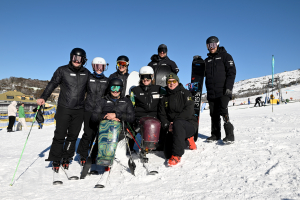Gear Guide – How to buy the right boots
![]()

The Transfer pro model, from the future. Illustration:: Louis Macindoe
Transfer | Gear Guide
Nothing is more crucial to your snowboarding than the fit of your snowboard boots. You literally walk the fine line of comfort and performance. Having a boot that prevents dreaded heel lift, and is comfortable enough to ride all day is the ultimate goal.
FIT:
All boots have a ‘break in period’ – meaning when new, you’ll want those toes to be just gently grazing the ends of the boot as they are designed to ‘pack out’ over time. The duration of this break-in period is dependent on the performance of the boot. For example, a stiffer boot will generally take longer to break-in, however it will give a much greater response than a softer boot, which will break-in within a couple of hours of wear.
Double socking is not an option; don’t buy a pair of boots that are too big just so you can fast track the break-in period. Your heel will start lifting like you’re wearing a pair of oversized pluggers, making toeside turns nearly impossible.
The Internet is no substitute for the sorcery of the local snowboard shop boot-fitter, these guys know your beetle stompers better than you do – so do yourself the favour and just surrender. Let them do their magic and your feet will thank you come opening weekend.
FLEX:
A boot’s flex is reflective of its intended purpose. If you’re into riding the park but geared more towards jibs and rails, you’ll want a boot that has a skate-shoe-like feel. Having a softer flex is better for tweaking out grabs, and it’s more forgiving.
Running a stiffer boot is a good idea for those wanting to ride larger sized jumps and the halfpipe as the response and support is much greater. A boot that offers this can improve your riding immensely – especially when it comes to stomping landings.
For everything else, it’s truly a matter of matching your riding style to the boot. If you enjoy ripping around at the speed of light, you’re going to want a stiffer boot so you don’t blow out on that Euro-carve. Just learning the ropes? You’re going to want a boot that’s plush and comfortable, rather than being solely performance-driven.
LINERS:
Choosing a boot with the right liner is an important part of getting an ideal fit. The liner provides cushioning, support and insulation to the boot’s construction.
There are three different boot liners available today on the market:
Standard liner: Found in base-model boots, which conform to your foot over time.
Mouldable liners: Found amongst the mid-range boots and are built to mould to your foot’s shape by your body heat
Heat moldable liner: Found in the premium range of boot offerings. These provide a true custom-fit to that club foot of yours before you even step onto snow. You’ll need the local shop guy to help you out with this.
LACING:
Personal preference comes into play here, choose which best suits you:
Traditional lacing: You know the deal, tie a knot in the thing and you’re done. It’s bulletproof and will almost never fail you. The only downside is effort…
Speed lacing: Nearly every boot manufacturer offers a quick-lace option in their range; this allows the rider to pull on handles that adjust the tension of the boots lacing ‘zones’ without actually having to tie a knot. Very handy for on-the-fly adjustments.
Boa lacing: Boa is a handy gadget that replaces the traditional lacing with wire and a sophisticated adjustment wheel. Boots have different Boa setups, such as having conventional lacing with a Boa-adjusted liner. Other boots can offer a complete Boa system with multiple adjustment wheels.
FOOTBEDS:
Often the most overlooked feature of a boot is the footbed. If you’ve experienced pain in your arches whilst snowboarding, chances are you’re going to need additional support. Your shop guru has you covered here; they’ll be able to fit you up with some custom beds for the cost of a case. A good footbed will not only improve fit but also provide dampening against harsh impacts.




